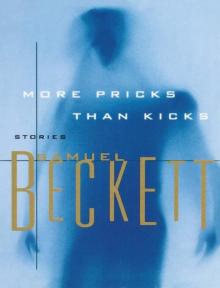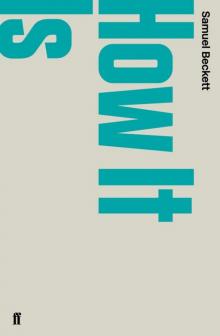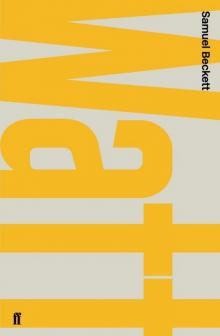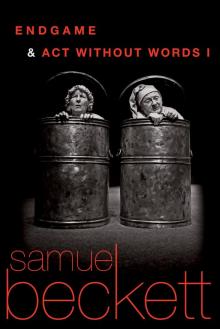- Home
- Samuel Beckett
Company / Ill Seen Ill Said / Worstward Ho / Stirrings Still
Company / Ill Seen Ill Said / Worstward Ho / Stirrings Still Read online
SAMUEL BECKETT
Company Ill Seen Ill Said Worstward Ho Stirrings Still
Edited by Dirk Van Hulle
Contents
Title Page
Preface
Table of Dates
Company
Ill Seen Ill Said
Worstward Ho
Stirrings Still
One Evening
The Way
Ceiling
what is the word
APPENDIX
Heard in the Dark 1
Heard in the Dark 2
About the Author
About the Editor
Titles in the Samuel Beckett series
Copyright
Preface
On the back of one of his manuscripts, Samuel Beckett calculated in 1977 how long he had been dying: approximately 600,000 hours since his birth on Good Friday 1906. There were, as it happened, approximately 100,000 hours to go. During this last decade, from Company in 1980 to Stirrings Still in 1989, Beckett wrote four of the most moving and unsettling prose works of the twentieth century, which form the core of the present edition. Company, Ill Seen Ill Said and Worstward Ho appeared independently, and were subsequently brought together by his publisher John Calder under the collective title Nohow On (June 1989); Stirrings Still appeared separately in April 1989.1 During this last decade Beckett also wrote a number of shorter prose texts, all of which are variously related to the four major works. These are also included in the present edition; the preface summarizes their different textual situations, following the order of composition, and pays attention to the process of composition.
Company
In January 1977, Beckett started writing an unpublished prose text known as ‘The Voice’ or ‘Verbatim’.2 Both titles appear on the manuscript of Company, preserved at the University of Reading.3 The Voice, ‘speaking of itself in the third person singular’, begins by saying that it will not cease ‘till hearing cease’. A close relationship between speaker and listener is intimated. When a character does appear, it is a ‘wayfarer’ who has been ‘out since dawn plodding forward through the gloaming’. There are other affinities with what was to become Company, notably the references – ‘for verisimilitude’ – to Ballyogan Roadand Croker’s Acres (close to Leopardstown racecourse and Foxrock, the suburb of Dublin where Beckett grew up), and the reference to a father’s shade.
Beckett abandoned ‘Verbatim’ in May 1977, but salvaged a few snippets when he integrated this fragment of prose into the characteristic structure of Company, which consists of fifty-nine discrete paragraphs. A number of these are presented as reminiscences in the second person singular (as in the one-act play, That Time, written slightly earlier): ‘Use of the second person marks the voice. That of the third that cankerous other’ (para. 3). This ‘other’ is described elsewhere as ‘Deviser of the voice and of its hearer and of himself. Deviser of himself for company’, like the solitary child who turns himself into children, mentioned in Endgame. The narrator calls his ‘hearer’ M. Formerly, the thirteenth letter of the alphabet served as the first initial of Beckett’s main characters, as in Murphy, Mercier, Molloy, Malone, devised for company. But as the last word of Company suggests the solitary man who turns himself into men is not Malone, rather ‘Alone’.
According to John Calder, on its first appearance Company ‘received more attention than any of Beckett’s prose works since Imagination Dead Imagine’ (fifteen years earlier), being read by Patrick Magee on BBC radio and performed in a dramatized version at the National Theatre. It has been suggested by John Banville that the relative popularity of Company ‘can at least in part be explained by the air of nostalgia that pervades it.’4 Aside from its many charged references to Beckett’s early life, Company is also a palimpsest of allusions to and echoes of his earlier work, as well as to the work of others, all of which form part of the text’s company.
Writing the final pages seems to have proved unusually difficult, and included an abortive attempt to graft a passage from A Piece of Monologue (itself in mid-composition), but by the end of July 1979 Company was finished. It was Beckett’s first major prose text in English since From an Abandoned Work (1956), and he started translating it into French on 3 August. After two years of composition, the translation as such took only twenty-four days. The French text was the first to be published (7 January 1980), and by the time the English version came out later in the same year, it had been revised in the light of Compagnie (published by Editions de Minuit).5 Although Beckett generally proof-read his late texts carefully, he did mention afterwards in a letter to Martha Fehsenfeld (18 November 1980) that ‘philogenitiveness’ in para. 51 should read ‘philoprogenitiveness’, which is how it appears in the present edition.
Two of the longest paragraphs of Company had been published independently: para. 39 as ‘Heard in the Dark 1’ in New Writing and Writers 17 (Calder, 1980) and para. 40 as ‘Heard in the Dark 2’ in Journal of Beckett Studies 5 (Autumn 1979). They contain minor variants. For instance in ‘Heard in the Dark 2’, when the boy tries to imitate his father’s chuckle the father is ‘amused’, whereas in Company he is ‘tickled’. Paras. 39 and 40 take their place in the structure of Company, but also have a separate self-contained existence, and an independent publication history; they are included here as an appendix.
One Evening
On 3 October 1979 Beckett’s friend Con Leventhal died. He had replaced Beckett as an instructor at Trinity College in Dublin half a century earlier, and married Beckett’s muse Ethna MacCarthy (the ‘Alba’ of Dream of Fair to Middling Women), and his death may have played a role in the genesis of Un Soir. The starting point of the French text, written on 24 October, is of a man lying on the ground, stumbled upon by an old woman in search of wild yellow flowers to decorate the grave of her dead husband. Not unlike Hamm’s chronicle in Endgame, the narrative is repeatedly interrupted by the narrator’s notes to himself. ‘All that seems to hang together,’ he concludes: ‘But no more about it.’
Beckett translated the text into English in the first week of November 1979, and One Evening was published in the Journal of Beckett Studies 6 (Autumn 1980). It has been read as an early version of the opening of Ill Seen Ill Said, notably in the shared use of prompts, or phrases spoken as if to camera. In this sense it is comparable to ‘Heard in the Dark 2’, but whereas the latter is an extract from work in progress on Company, One Evening stands in a far more independent relation to Ill Seen Ill Said. After its first publication it appeared subsequently in art press 51 (September 1981) and in New Writers and Writing 20 (Calder, 1983).
Ill Seen Ill Said
If Company may be described as partly autobiographical, Ill Seen Ill Said has as its main character an old woman. Narrated in the third person, its sixty-one unnumbered paragraphs in French can be seen as a counterpart to Company with its not-quite sixty paragraphs written in English. The original French manuscript, however, consisted of sixty-four numbered fragments, suggesting a chessboard structure. In an exercise notebook Beckett drew up an outline which succinctly labels the contents of each paragraph. He began translating Mal vu mal dit on 10 December 1980, even as the French original was still being written and revised (between October 1979 and January 1981). On the first page of the English manuscript, the text was provisionally titled ‘The Evening or the Night’. The translation was completed in one month and on the last page Beckett inscribed the definitive title ‘Ill Seen Ill Said’. It was first published complete in the New Yorker (5 October 1981), and subsequently in volume-form by Grove Press (1981).6 The first English trade edition appeared
from Calder in 1982, and the text was performed on BBC Radio 3 by Patrick Magee in September 1982.7
As in all of these late works, Shakespeare is never far away. The French ‘oeil las’ (para. 51) was originally translated as ‘weary eye’ but in the second typescript Beckett replaced it by ‘vile jelly’, referring to the moment in King Lear when Gloucester is blinded. The revision coincided with Beckett’s copying a few lines from King Lear into the so-called ‘Sottisier’ notebook – lines spoken by Gloucester’s son and relating to his blind father’s lament: ‘I have no way.’This ‘no way’ is the background against which Beckett’s next text took shape.
The Way
This short prose text was written in mid-May 1981, between two trips to Stuttgart, where Beckett was helping the Süddeutsche Rundfunk production of Quad, his wordless ‘ballet’ for television (whose geometrical quincunx can be seen as combining the two signs which announce respectively the two paragraphs of The Way: 8 and ∞). As Beckett indicated on the manuscript, The Way was a provisional title. Nonetheless it is generally preferred to ‘Criscross to Infinity’, the title ‘foisted on Beckett’8 for the work’s publication in College Literature 8, no. 3 (1981).
The route describes the shape of an infinity symbol, from foot to crown and back. An addition to the first manuscript version specifies: ‘The two ways were one way’, in reference to Beckett’s old philosophical notes on the Presocratics, notably a fragment of Heraclitus quoted in John Burnet’s Greek Philosophy (1914): ‘The way up and the way down [are] one and the same […] Fire, water, earth is the way down, and earth, water, fire is the way up. And these two ways are forever being traversed in opposite directions at once.’ Beckett had already made irreverent use of this philosophical trope fifty years earlier in Dream of Fair to Middling Women, where Belacqua discovers the line of the ‘drink graph’ looping back on itself like an eight: ‘if you had got what you were looking for on the way up you got it again on the way down. The bumless eight of the drink figure. You did not end up where you started, but coming down you met yourself going up.’9
So, while The Way can be read as a realistic description of a ‘wayfarer’ in a familiar Beckettian landscape, or calvary, it is also the brief translation of a philosophical metaphor and a way of thought: ‘Well on the way to inexistence,’ in the words of Ill Seen Ill Said: ‘as to zero the infinite.’
Ceiling
The way was paved for this brief text by Beckett’s shortest poem, written on 9 April 1981 in the ‘Sottisier’ notebook:
Ceiling
lid eye bid
byebye
No sooner have the eyes opened than the business of dying sets in. In July 1981, Beckett wrote a prose Ceiling, provisionally titled ‘On Coming to’ in the manuscript. The point of departure for Ceiling had been reached as early as Murphy in the 1930s: ‘When he came to, or rather from, how he had no idea, the first thing he saw was the fug.’10 In Ceiling this premise becomes a study of consciousness as a return to consciousness, as consciousness regained. Intended as a contribution to a monograph devoted to the painter, Avigdor Arikha, Beckett completed a first version in Courmayeur on 10 July 1981, and a second version in Paris dated 26 July 1981. On 7 September he gave the typescript to the painter’s wife Anne Atik (who reproduces it in her memoir How it Was, 2001), with the superscription “for Avigdor/September 1981”; the original title was crossed out, with Somehow again substituted by pen. Eventually the title reverted to Ceiling. Anne Atik notes that Beckett ‘had planned to write about A.’s work for him, but decided to write a text about seeing, instead, which became Ceiling, as having much more to do with A.’s approach’.11 No French version was undertaken by Beckett. Ceiling was first published in Arikha (Richard Channin and others; Hermann, Paris, and Thames & Hudson, London, 1985), thereafter in the book-catalogue Avigdor Arikha: From Life: Drawings and Prints 1965–2005, edited by DuncanThomson and Stephen Coppel (the British Museum Press, 2006), and latterly in Fulcrum 6 (Boston, 2008) with a note by Christopher Ricks. Two weeks after finishing Ceiling Beckett began the first draft of Worstward Ho, on 9 August 1981. As the provisional title Better Worse indicates, this work can be read as a set of staccato variations on the Shakespearian theme that ‘The worst is not / So long as one can say, This is the worst.’ (as copied out in the ‘Sottisier’ notebook). The idea of being ‘Well on the way to inexistence’ is further elaborated in the so-called ‘Worstward Poems’ at the back of the first manuscript of Worstward Ho, which precede two schematic drawings of the scenic movements in Quad. Two of these ‘Worstward Poems’ are variations on the theme ‘on whence / no sense / but on / to whence / no sense’. These are followed by a so-called ‘Poetic miscalculation’:
from y to z
95.1 %
to the dearest decimal dead
incalescent
The notion of getting hotter – incalescent – or of being close to the ‘worst’ but not quite there yet, characterizes Beckett’s late texts, but in Worstward Ho it is explicitly acted out in language. As the line from King Lear indicates, the word ‘worst’ is inadequate, for as long as it can be uttered, the situation can worsen. This challenge is the greatest paradox for the writer.
Since a spoken or written ‘worst’ cannot be the absolute worst, some aspects of the transmission of this text also touch on its thematic core, not least the variants between ‘worse’ (final typescript) and ‘worst’ (Calder) in para. 61. The American Grove (1983) and Calder text (1983) differ in six instances, analysed by Ruud Hisgen and Adriaan van der Weel.12 According to John Calder, discrepancies between the final typescript and the Calder edition are probably the result of revisions made by Beckett in proof, but unfortunately the proofs are lost. The author’s final typescript (preserved at the Fonds John Calder, IMEC, Normandy) has been followed as the base text for the present edition.
Stirrings Still
Beckett’s last independent prose work was written in English and French between 1983 and 1987. The text of the limited edition of Stirrings Still contains one error (‘withersoever’ instead of ‘whithersoever’), pointed out to Beckett by the actor Barry McGovern, and immediately corrected by the author in McGovern’s copy, which may therefore serve as a base text, rather than the initial newspaper publication in the Guardian and Irish Independent (3 March 1989), or in the Manchester Guardian (19 March 1989). Apart from a few textual errors, the text in the Guardian is subdivided into four instead of three sections. The version in the Irish Independent is punctuated by cartoons, as in the case of the publication of Ill Seen Ill Said in the New Yorker, whereas the limited edition is illustrated with lithographs by Louis le Brocquy. Stirrings Still was thereafter collected with other uncollected late texts in As the Story Was Told (Calder 1990). It was dedicated to Barney Rosset, who had been dismissed as chief editor at Grove Press in April 1986.13 By way of helping him, Beckett was stimulated to revise two previously written fragments of prose and eventually to add a third, to produce the work that became Stirrings Still.
The title draws on para. 26 of Company: ‘Pangs of faint light and stirrings still. Unformulable gropings of the mind. Unstillable.’ The genesis of Stirrings Still – with its reiterated Beckettian theme of a man seeing himself rise and disappear – was long and complex, including uncertainty as to which language to use. On the first manuscript page (dated 27 June 1983), Beckett began with a ‘fragment’ in French, which he then reworked in English. Whereas the second page opens with an English paragraph, followed by a new attempt in French. Eventually Beckett opted for English. The exercise book containing early drafts of Stirrings Still also features two abandoned dramatic fragments referring to Shakespeare’s sonnets. There are spectral references to Beckett’s life, for example in the allusion to Arthur Darley (‘Darly’), his doctor-friend from his days with the Irish Red Cross in Normandy in 1945, who was to die of tuberculosis a few years later. Among the more explicit references in the text is an allusion to Beckett’s favourite poem by the medieval German poet Walth
er von der Vogelweide, which describes the poet sitting on a stone and considering how one should live on this earth. But the most remarkable reference is a concealed allusion to Beckett’s lifelong master, Dante.
In the last of the text’s three numbered sections, the protagonist hears something ‘from deep within’, a sentence containing one word he cannot distinguish: ‘oh how and here a word he could not catch it were to end where never till then’. He cannot catch the word because it is too ‘faint’. When Beckett had written ‘faint’ in his manuscript on the right-hand side of his notebook, this apparently reminded him of an Italian phrase, which he wrote down on the left-hand page: ‘per lungo silenzio fioco’ – immediately followed by a translation, hesitating between ‘faint’ or ‘hoarse from long silence’. This passage, from the opening canto of the Divina Commedia, decribes how the guide Virgil appears to Dante, just before the poet calls him ‘maestro’. Beckett subsequently considered replacing the word ‘faint’ in the draft by ‘hoarse from long silence’ but decided against it, and stuck to ‘faint’. So at the surface level eventually nothing changes and in the published version there is no direct indication of a link with Dante. Nonetheless, its presence in the manuscripts indicates a Dantean dimension that may be relevant in the search for ‘that missing word’.
what is the word
what is the word is Beckett’s translation of Comment dire, a fifty-three-line poem which constitutes his last published writing. ‘Quel est le mot?’ was still the pressing question when he was in the Hôpital Pasteur, and then in the nursing home Le Tiers Temps, in July 1988. On the first manuscript page he changed the key line from ‘quel est le mot—’ to ‘comment dire—’ followed by hyphens, or what he called ‘traits de désunion’. On 29 October he wrote out a fair copy, a facsimile edition of which was produced for the librairie Compagnie in May 1989. The French text appeared in the literature section of the newspaper Libération on 1 June 1989 under the heading ‘Un poème inédit’.

 More Pricks Than Kicks
More Pricks Than Kicks Happy Days
Happy Days Breath, and Other Shorts
Breath, and Other Shorts Endgame & Act Without Words
Endgame & Act Without Words The Collected Shorter Plays of Samuel Beckett
The Collected Shorter Plays of Samuel Beckett The Complete Short Prose, 1929-1989
The Complete Short Prose, 1929-1989 Stories and Texts for Nothing
Stories and Texts for Nothing Waiting for Godot
Waiting for Godot Rockaby and Other Short Pieces
Rockaby and Other Short Pieces First Love and Other Shorts
First Love and Other Shorts How It Is
How It Is Disjecta: Miscellaneous Writings and a Dramatic Fragment
Disjecta: Miscellaneous Writings and a Dramatic Fragment Echo's Bones
Echo's Bones Texts for Nothing and Other Shorter Prose 1950-1976
Texts for Nothing and Other Shorter Prose 1950-1976 Three Novels
Three Novels Murphy
Murphy Mercier and Camier
Mercier and Camier Eleuthéria
Eleuthéria Selected Poems 1930-1988
Selected Poems 1930-1988 Dream of Fair to Middling Women
Dream of Fair to Middling Women Watt
Watt Krapp's Last Tape and Other Dramatic Pieces
Krapp's Last Tape and Other Dramatic Pieces The Complete Dramatic Works of Samuel Beckett
The Complete Dramatic Works of Samuel Beckett Worstward Ho
Worstward Ho Collected Poems in English and French
Collected Poems in English and French Company / Ill Seen Ill Said / Worstward Ho / Stirrings Still
Company / Ill Seen Ill Said / Worstward Ho / Stirrings Still Ends and Odds
Ends and Odds Endgame Act Without Words I
Endgame Act Without Words I Rockabye and Other Short Pieces
Rockabye and Other Short Pieces The Collected Shorter Plays
The Collected Shorter Plays The Complete Dramatic Works
The Complete Dramatic Works Three Novels: Malloy, Malone Dies, The Unnamable
Three Novels: Malloy, Malone Dies, The Unnamable The Unnamable
The Unnamable